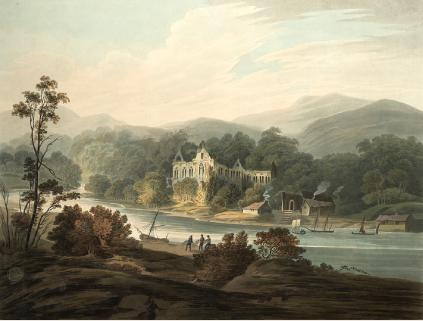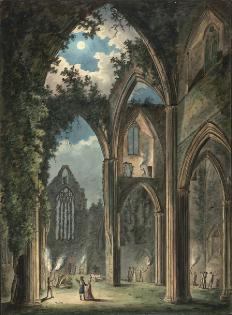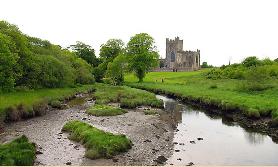

Chapel Hill or Tintern Abbey
(A description written in 1891)
A Parish on the banks of the river Wye and on the high road leading from Chepstow to Monmouth, 132 miles from London, 5.1/2 north from Chepstow, 10.1/2 from Monmouth and about one south-west from Tintern station on the Wye Valley branch of the Great Western railway; in the South division of the county, upper division of Raglan Hundred; Petty Sessional division, Union and County Court district of Chepstow; eastern division of the rural deanery of Netherwent, archdeaconry of Monmouth and diocese of Llandaff.
For parochial purposes the parish is named Chapel Hill, but probably it is more widely known as Tintern Abbey, from the fact that the ruined abbey of that name stands within its boundary. The tourist coach ("The Eclis") runs to and from Chepstow daily during the summer months, and there are boats sailing from Chepstow, the distance by water being 9 miles.
The church of St Mary is a building of stone, partly Early English, with later portions in a debased Gothic style; it consists of chancel and nave under one roof and a saddle-back tower containing one bell; the church was almost entirely rebuilt in 1866, and has about 100 sittings, all free. The register of Baptisms and Burials date from the year 1695; marriages, 1770. The living is a vicarage, gross annual value £68, of which £10 is paid in lieu of Abbey lands, and the remainder arises from rent of land purchased by Queen Anne's Bounty: it is in the gift of the Duke of Beaufort, and held since 1889 by the Rev. Charles Henry Piggott. Parish Clerk: William Jones
There is also an ancient chapel, dedicated to St. Anne, some portion of which is incorporated with the residence of John Loraine Baldwin Esq.
Here are Wesleyan and Baptist Chapels and one for Bible Christians.
Charities:
 1) Thomas Hackett, of Penterry, by indenture darted December 10th, 1634; reciting that Philip Hackett, late of the City of London, gentleman (eldest son of the said Thomas Hackett), then deceased, had left by will £15 to the poor of the parishes of Chapel Hill and Tintern Parva, and that Thomas Hackett had himself given £5 to the poor; he accordingly conveyed to William Cathmay and others twelve acres of land called Monck Redding, in the parish of Mounton, in lieu of the said sums of £15 and £5, the rents and profits of the land to be for the use of the said poor.
1) Thomas Hackett, of Penterry, by indenture darted December 10th, 1634; reciting that Philip Hackett, late of the City of London, gentleman (eldest son of the said Thomas Hackett), then deceased, had left by will £15 to the poor of the parishes of Chapel Hill and Tintern Parva, and that Thomas Hackett had himself given £5 to the poor; he accordingly conveyed to William Cathmay and others twelve acres of land called Monck Redding, in the parish of Mounton, in lieu of the said sums of £15 and £5, the rents and profits of the land to be for the use of the said poor.
2) Francis Bedford, by will, dated June 18th, 1656, left an annual sum of £6, payable out of a certain farm at Llangattock-juxta-Usk, for putting out one poor boy apprentice yearly, the preference to be given to his own kindred.
3) Samuel Pritchard, by will, dated December 27th, 1810, bequeathed £1,000 £5 per Cent, annuities, the proceeds to be distributed amongst the poor annually on St Stephen's day.
4) The poor of Chapel Hill have also the rents of a field at Penterry, called "Poor's Leic."
In the Parish is a wire and tinplate manufactory said to have been originally founded by Swedish and German colonists, about the time of the Restoration.
Post: Letters: through Chepstow arrive at 7.30 a.m. The nearest post, money order & telegraph office is at Tintern.
Schools:
National School, for boys, girls & infants, for this & the parish of Tintern, holds 130 children; average attendance, 118; Edwin Wild, master.
Tintern Railway Station: James E Gale, station master
 The Benedictine Abbey of Tintern, situated in the bosom of lofty wooded hills, on a bend of the river
The Benedictine Abbey of Tintern, situated in the bosom of lofty wooded hills, on a bend of the river
![]()

Within a short distance of the mouth of the Bay of Bannow, in the county of Wexford, at the foot of a lofty hill, stands the ancient ruin of Tintern Abbey, a picturesque and imposing object. It was originally founded by William, Earl Marshall of England, and Earl of Pembroke, who married the lady Isabella de Clare, daughter of Earl Strongbow by his second wife, the Princess Eva Macmorrogh, in whose right he claimed the lordship of Leinster. The Earl of Pembroke, when in great danger at sea, made a vow that, if he escaped, he would found an abbey on the spot where he landed in safety. His bark found shelter in Bannow Bay, and he scrupulously performed his vow by founding this abbey, which he dedicated to the Virgin Mary, and filled with Cistercian monks, whom he brought from Tintern, in Monmouthshire, a monastery that owed its foundation to the house of De Clare.
(from The Dublin Penny Journal - Vol. 2, No.100, May 31, 1834)
Tintern Abbey, Co. Wexford - photo © Pam Brophy
Wye, was founded May 9th, 1131, by Walter De Clare, and colonised from L'Aumone. The extreme beauty of its position and its inherent picturesqueness have made it justly celebrated, but it is equally worthy of admiration for its architectural character, which belongs to a Transitional style between the Early English and Decorated periods, and which for excellence of composition and delicacy of execution is rivalled by few similar structures in the kingdom. The church, begun in 1287, remains nearly complete, with the exception of the northern arcade of the nave, which is of six bays: the choir proper consists of four bays, with large aisles, but has no triforium: the fine east window is 69 by 27 feet: the ritual choir extended one bay westward from the crossing, where the rood loft had a central door and lateral altars: the north wing of the transept, 110 feet in total length, retinas the dormitory stairs, the cloister being on that side: in the south wing is the visitors' door: each wing had two chapels: outside the western entrance was a transverse Galilee: on the east side of the cloister, 111 by 99 feet, are the aumbry, the parlour and sacristy, the chapter house, 56 by 28 feet, with three alleys, the slype to the infirmary, the day stairs to the dormitory and the undercroft, 88 x 27 feet, and on the north side are the postern and river gate, with the abbot's abode over, the buttery, the refectory, 82 by 29 feet, with its pulpit and offices, and kitchen: to the north-west, built over an undercroft, is the guest house, and an arch of the water gate also remains: the whole length of the church is 245 feet. Edward II, once took refuge here. At the time of the suppression of the Abbey there were 15 monks. The revenues of the Abbey at the Dissolution are stated to have been £256 11s. 6d. yearly, which would probably represent at the present time [1891] an income little short of £4,000. After the Dissolution, the site of the monastery was granted to the Earl of Worcester, with whose descendants it has remained until the present day.
The Duke of Beaufort is lord of the manor and principal landowner. The soil is sand and light loam. The chief crops are barley, oats, potatoes and apples. The area is 1,263 acres, half of which are woods and 71 of tidal water and foreshore; rateable value, £1,778.
The population in 1881 was 307.
Tintern Abbey engravings c.1815 courtesy of & © The British Library
Click here to download a nice little book entitled "Picturesque Scenery on the banks of the Wye between Ross & Chepstow"- free download from archive.org
(extracts from Kelly's 1891 Directory of Monmouthshire, transcribed by J. Doe)
Caldicot Male Voice Choir sing Eli Jenkins Prayer at Tintern Abbey, May 17th 2014

Aberbargoed • Aberbeeg • Abercarn • Abergavenny • Abersychan • Abertillery (also see Aberystruth) • Aberystruth • Basseleg • Bettws (near Llantillio Pertholey) • Bettws (near Newport) • Bettws Newydd • Bishton • Blackwood • Blaenavon • Blaina • Briery Hill • Bryngwyn • Bwlch Trewyn • Caerleon or Llangattock-Juxta-Caerleon (see Christchurch for Caerleon Village) • Caerwent • Caldicot • Castleton • Cefnycrib • Chapel Hill • Chepstow • Christchurch (also see Newport) • Clawrplwyf • Coedkernew • Coed y Paen • Crick • Croesyceiliog • Cross Ash • Cross Keys • Crosshands • Crumlin (also see Llanhilleth & Mynyddislwyn) • Cwm (also see Ebbw Vale) • Cwmavon (also see Trevethin) • Cwmbran (also see Llanvihangel Llantarnam & Llanfrechfa) • Cwmcarn • Cwmcarvan • Cwmffrwdoer • Cwmnantddu • Cwmtillery (also see Aberystruth) • Cwmynyscoy • Cwmyoy • Devauden • Dewstow • Dingestow • Dinham • Dixton Newton • Duffryn • Earlswood • Ebbw Vale • Fleur-de-Lys • Freehold • Garndiffaith (also see Trevethin) • Garndyrris • Garnfach • Gellygroes • Glascoed • Goldcliff • Golynos • Govilon • Goytre • Graig • Griffithstown (also see Llanfrechfa & Panteg) • Grosmont • Gwehelog • Gwernesney • Hardwick • Henllys • High Cross • Highmoor Hill • Howick • Ifton • Itton • Kemeys Commander • Kemeys Inferior • Kilgwrrwg • Langstone • Little Mill • Llanarth • Llanbadoc • Llanbedr • Llandavenny • Llandewi Fach • Llanddewi Rhydderch • Llanddewi Skirrid • Llandegveth • Llandenny • Llandevaud • Llandogo • Llanellen • Llanfaeneor • Llanfair Discoed • Llanfair Gilgoed • Llanfair Kilgeddin • Llanfihangel Crucorney • Llanfihangel Gobion • Llanfihangel juxta Roggiett • Llanfihangel Llantarnam • Llanfihangel nigh Usk • Llanfihangel Pont y Moile • Llanfihangel Tafernbach • Llanfihangel Tor y Mynydd • Llanfihangel Ystern Llewern • Llanfihangel y Vedw • Llanfoist • Llanfrechfa • Llangattock • Lingoed • Llangattock nigh Usk • Llangattock Vibon Avel • Llangeview • Llangibby • Llangoven • Llangua • Llangwm Ishaf & Llangwm Uchaf • Llanhennock • Llanhilleth • Llanishen • Llanllowell • Llanmartin • Llanover • Llanrumney • Llansantffraed • Llansoy • Llanthewy Rytherch • Llanthewy Skirrid • Llanthewy Vach • Llanthomas • Llanthony • Llantillio Crossenny • Llantillio Pertholey • Llantrissent • Llanvaches • Llanvair Discoed • Llanvair Kilgeddin • Llanvapley • Llanvetherine • Llanwenarth Citra • Llanwenarth Ultra • Llanwern • Lliswerry • Llwyndu • Machen (Upper & Lower) • Maes-y-cwmmer • Magor • Maindee (also see Christchurch & Newport) • Malpas • Mamhilad • Marshfield • Mathern (also see St Pierre) • May Hill • Michaelston y Fedw • Mitchel Troy • Monkswood • Monmouth • Mounton • Mynyddbach • Mynyddislwyn • Mynyddmaen • Nantyderry • Nantyglo • Nash • New Town • New Tredegar • Newbridge • Newcastle • Newchurch East & West • Newport • Nightingale Village • Oldcastle • Overmonnow • Panteg • Par Grace Dieu • Pen y Clawdd • Penalt • Penbiddle • Pengam • Penhow • Penmaen • Penpergwm • Penrhos • Penrose • Penterry • Pentrepeod • Penygarn • Penyrheol • Peterstone Wentloog • Pillgwenlly • Ponthir • Pontllanfraith • Pontnewydd (also see Llanfrechfa) • Pontnewynydd • Pontrhydyryn • Pontygof • Pontymister • Pontymoile • Pontypool • Pontywain • Porthcasseg • Portskewett • Pwll Du • Pwllmeyric • Raglan • Redbrook • Redwick • Rhydgwern • Rhymney • Risca • Rock • Rockfield • Rogerstone • Roggiett • Rumney • Runston (also see Mathern) • St Arvans • St Brides Netherwent • St Brides Wentloog • St Kingsmark • St Lawrence • St Maughans • St Mellons • St Pierre (also see Mathern) • St Woolos • Sebastopol (also see Panteg) • Shirenewton • Sirhowy • Six Bells • Skenfrith • Snatchwood • Somerton Common • Sudbrook • Talywain (also see Trevethin) • The Race and Upper Race • Tintern Abbey • Tintern Parva • Tranch • Tredegar • Tredunnock • Tregare • Trellech • Trellech Grange • Trevethin • Treworgan • Trostrey • Undy • Upper Machen • Usk • Varteg • Victoria • Waunlwyd • Whitebrook • Whitson • Wilcrick • Wolvesnewton • Wonastow • Wyesham • Ynysddu
All images unless otherwise credited are © MonGenes and may not be reproduced without permission
© MonGenes 2013


 Flag of St David
Flag of St David